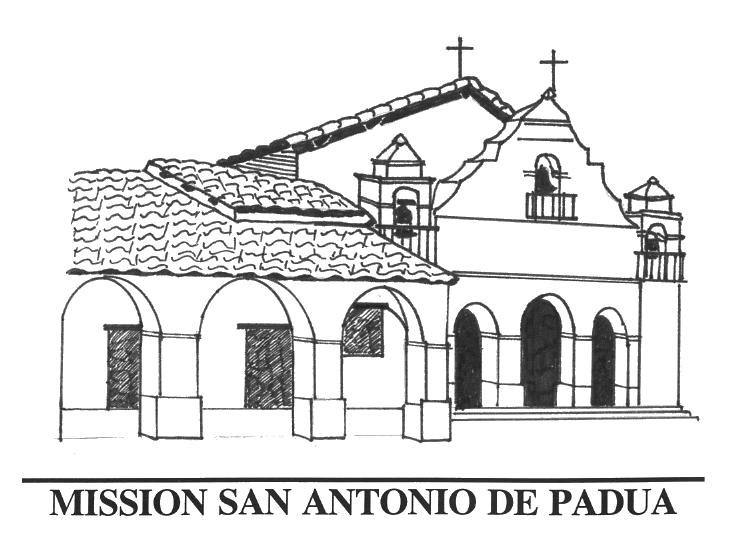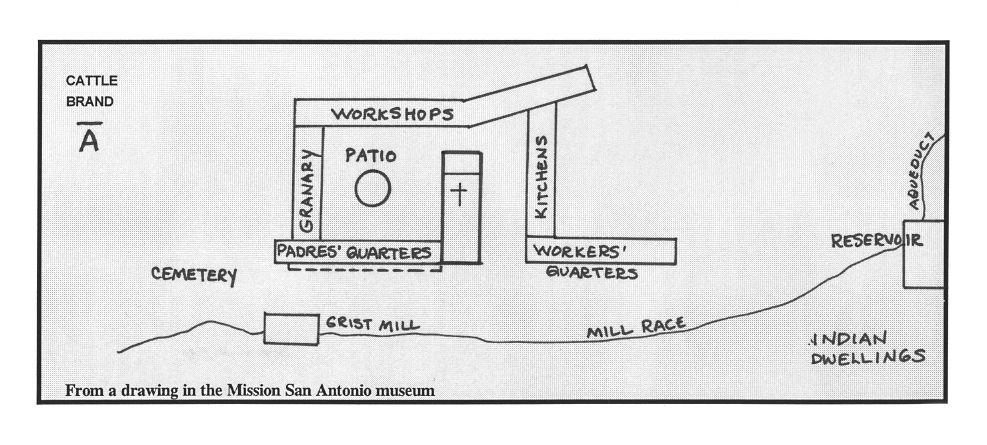| ||||
|
| ||||
|
MISSION
SAN ANTONIO DE PADUA
P.O. Box 803
Jolon,
CA
93928
Established: July 14, 1771
By: Father Junípero Serra, Franciscan missionary, President of the missions.
Order: 3rd of the 21 missions.
Location:
60 miles SE of Monterey in a valley of the
Named: In honor of Anthony of Padua, a 13th-century Franciscan priest known as the miracle worker. De las Robles (“of the oak trees”) is sometimes added to the name.
California Historical Landmark No. 232
DESIGN OF THE MISSION
Church: 200 feet long, 40 feet wide. Made of adobe bricks. Tile roof (the first use of tile to roof a church in California).
Style: Plain exterior noted only for the campanario (bell wall) that decorates the front, and the barrel vault that leads into the church. The floor is cobblestone covered with a layer of plaster (unlike most of the mission churches which had tile floors). Ceiling is made of timbers, vaulted, and painted blue with stars over the altar. Native designs decorate the interior.
Walls: Six feet thick at the bottom, varying to five feet thick at the top.
Campanario: Made of burnt brick with arched openings for three bells, the campanario is connected to the church by an enclosed passageway with an arched roof (called a barrel vault), also made of burnt brick.
Mission Compound: A quadrangle of buildings around a patio included padres' living quarters, dormitory rooms, shops for weavers and other crafts people, a winery, granary, and storerooms.
Mission Grounds: Near the mission compound the Salinan Indians built their dwellings to live in while they assisted with the construction of the mission. Around the mission were large vineyards, olive groves, and wheat fields. The wheat was threshed at the mission and ground into flour at the grist mill, which was the first water-powered grinding mill in California. Mission San Antonio was also famous for the horses which were raised here. At one time the mission had over 800 horses.
Water System: Dams were built on the San Antonio River about three miles above the mission, and the water brought down through aqueducts and stored in reservoirs. The aqueducts (the first in California) were made of 750 clay pipes on a tile bed, covered with shale. The water was used to turn a waterwheel that operated the grist mill. There were also pools for laundry and bathing. A fountain was added in modern times.

EARLY HISTORY
1771 Father Serra hung a bronze bell on an oak tree, raised a cross, and dedicated the site, naming it and the nearby river (Río de San Antonio). Fathers Buenaventura Sitjar and Miguel Pieras were left in charge of building the mission.
1773 Mission
was moved less than three miles to present site on
1775 Small church was built of adobe.
1779-1781 Larger adobe church was completed with a tile roof (according to Serra's diary, the first tile roof on a church in California). The red tile roof has become a symbol of the California missions.
1790 Large wing added to accommodate the growing numbers of people.
1806 Water-powered grist mill completed, the first in California.
1810-1813 Larger church built on a 10-foot rock foundation.
1821 Campanario and barrel vaulted passage added to the front of the church.
1834 Mission secularized (taken from the Franciscans by the government).
1845 Buildings offered for sale but no one bought them.
1851 Mission and 33 acres of land returned to the Catholic Church; Father Dorotea Ambris, a Mexican friar, took charge.
1882 Father Ambris died and the mission was abandoned.
1928 Franciscan friars from Mission San Miguel began to hold services here.
MISSION SAN ANTONIO TODAY
An early attempt at restoration of Mission San Antonio was made beginning in 1903 when the California Historic Landmarks League, led by Congressman Joseph R. Knowland, chose San Antonio as its first project. Stormy weather and the 1906 earthquake undid some of the restoration. The church was rebuilt in 1907, but the project was then abandoned.
When the second restoration effort began in 1948, the existing buildings had to be leveled to the ground. Under the direction of Harry Downie and financed by the Hearst Foundation (William Randolph Hearst then owned all the land around the mission) and the Franciscan Order, a complete rebuilding of the church and quadrangle took place. The restoration was aided by Salinan descendants of those who had helped to build the original mission, using some of the same techniques. New adobe bricks were made from the ruins of the old walls.
The restored padres' quarters houses a museum. There is a model of a pottery and tile shop showing how the mission workers made the adobe bricks and tiles. Part of the original reservoir and aqueduct are visible nearby.
Father Buenaventura Sitjar, who spent 37 years at Mission San Antonio, accomplished the task of putting the native Mutsun language into writing. He left behind a grammar and dictionary that he had compiled.
Mission San Antonio is an active parish church, serving the people of the area. Since 1948 the Franciscans have been in residence here. Of all the California missions, this is the one whose surroundings are most like they were in the early days of the missions. The one remaining original mission bell, called Osquila, rings out over an isolated, rural setting, just as it did in 1821.
